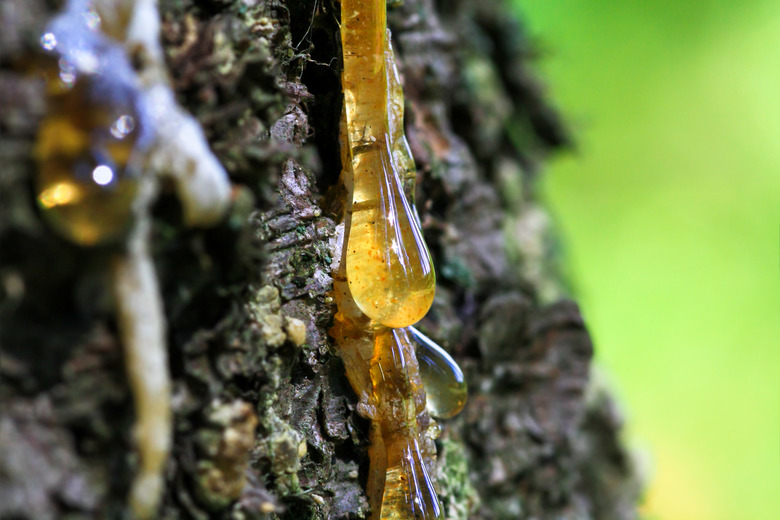How To Care For A Pine Tree With Leaking Sap
We may receive a commission on purchases made from links.
Properly caring for a pine tree (Pinus spp.) will ensure it stays healthy and looks as attractive as possible. Like most tree types, pines can require special care to keep them at their best. One important aspect is understanding the production of sap and how to care for a pine tree with leaking sap. Some level of sap leakage is normal, but if you're noticing that your tree seems to be leaking copious amounts of sap, there may be a bigger issue.
What Is Sap?
What Is Sap?
Pine trees and most other types of plants rely on specialized tissues to transport sap composed of water, sugars and additional nutrients down from the leaves to the roots and other parts of the plant; different specialized tissues carry water and minerals from the roots up. Sap is a thick, sticky liquid that's usually a golden-brown or amber color.
Sap is a crucial part of your pine tree's health and is produced year-round, although production amps up in spring and early summer. In the winter months, your tree may end up leaking some sap, which is okay. But if there's more than a small amount, it could be a sign of a problem.
Causes of Leaking Sap
Causes of Leaking Sap
Broken branches and pruning can be primary causes of leaking sap on a pine tree. If your tree has several areas of damage to its trunk and branches, sap will be exposed through these wounds.
There are more pernicious reasons your pine tree may be leaking sap. If you see multiple small holes in the trunk of your tree, it's likely that the leaking sap is a result of borer insects. These are small pests that dig into your tree's trunk and feed on it from the inside.
Another pest that can cause a pine tree to leak sap is the sapsucker. Sapsuckers are a species of woodpecker that damage trees by drilling uniform 1/4-inch holes in the tree trunk in distinctive circles (as opposed to the random hole patterns created by borer insects). The best way to discourage sapsuckers is by covering your tree's trunk with a sheet of burlap or a sticky insect barrier.
Pine tree fungi can also create an excess of sap. When fungi attack a pine tree and begin to grow underneath the bark, dead spots called cankers can form. Cankers tend to look like sunken areas or deeper cracks in your tree's bark. Keep in mind that healthy sap should always be golden brown in color. If you're noticing any other sap color (particularly white), it may be a sign of a pest or disease.
Managing Excessive Sap
Managing Excessive Sap
Depending on the cause of the leaking sap, there are different methods you can use to manage it. If it's a broken branch, you can prune it off, but you may just have to wait to allow the pruning wound to heal. While there are products on the market designed to seal pruning wounds, it's better to allow your trees to heal naturally. The addition of sealants can interfere with your tree's wound response and cause further issues down the line.
Cankers can be a big issue, and if you don't catch them early, they may not be treatable. However, if you notice a canker early enough, you can prune out the affected area, which may allow the rest of your tree to recover. Be sure to prune back to healthy growth, at least 6 inches below the canker. Disinfect your pruning tool by wiping or dipping the blades in rubbing alcohol between cuts to avoid spreading diseases.
If the reason your pine tree is leaking sap is due to borer insects, Purdue University Extension suggests spraying the trunk with an insecticide that's available for residential use, such as bifenthrin or carbaryl. Carefully read and follow all package instructions, including safety precautions, timing, application, reapplication, storage and disposal information.
Take additional steps to preserve the health of a young pine tree by pulling off gummy wads of sap, which attract pests; feeding and watering the tree as needed; and avoiding mower injuries and midsummer pruning. Mature pines that are in good health are less likely to succumb to a borer assault. If a large, mature tree develops a serious borer or disease problem, contact a certified arborist in your area for assessment and treatment or removal.
References
- HMI: What Time of Year Do Pine Trees Drip Sap (and Can I Stop It?)
- University of Nebraska, Lincoln: Tree Pruning Frequently Asked Questions
- Iowa State University: There Are Several Bands of Holes Around the Trunk of My Pine Tree. Is the Tree Infested With Borers?
- Purdue University Extension: Borers of Pines and Other Needle Bearing Evergreens in Landscapes
- Texas A&M AgriLife Extension: What Is Sap?
- Utah State University Extension: Pest Advisories: Borers and Sandflies
- University of Florida IFAS: Disinfecting Your Garden Tools
